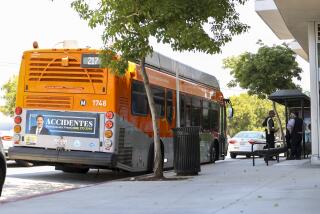You Say You Want a Revolution in Mass Transit?
- Share via
Imagine: A mass transit agency that has increased bus ridership by 120%, increased hours of service by 126%, reduced costs by 55% and generates more money from the fare box.
Now imagine a graffiti-free bus, because the operating company is fined if graffiti isn’t cleaned off within a specified time. On top of all that, imagine a bus fare 34% cheaper than the Metropolitan Transportation Authority’s and an unlimited senior pass that’s also 34% cheaper than the MTA.
You can’t imagine any of that? You say I’m a dreamer? Well, you’re partially right. This fantasy does exist: It’s called the Foothill Transit Zone and it’s thriving in the San Gabriel Valley. As for the dream, it’s called the San Fernando Valley transit zone, and today it exists only in our minds and on paper.
Ten years ago, merging the old Southern California Rapid Transit District and the Los Angeles County Transportation Commission into the MTA was part of a larger transportation vision I had for Los Angeles. It was a vision that included a balanced system that was safe, clean, accessible, reliable and inexpensive. It was impossible to predict that the MTA would sacrifice all its other services on the altar of subway tunnels.
Residents of that other valley concluded that they weren’t being served by the RTD and petitioned to create an independent Foothill Transit, locally run and managed.
The results have been spectacular, so much so that for several years many of us have been working to create such a zone in the San Fernando Valley.
The Valley zone would be a cooperative effort of the San Fernando Valley, the western cities of Agoura Hills, Calabasas, Hidden Hills and Westlake, the eastern cities of San Fernando, Burbank, Glendale and La Canada-Flintridge and Los Angeles County, which would enter into a joint powers agreement. A nine-person board would be created representing these areas and it would prepare the application for a transit zone.
But apparently the prospects of local self-determination and the opportunity for success were too big a threat for some City Hall power brokers.
First there was special-interest legislation introduced in the state Legislature that would have make it almost impossible for a Valley transit zone to be created.
It was passed despite overwhelming opposition from business and community leaders. Fortunately, Gov. Gray Davis vetoed the bill, calling it an unnecessary intrusion in local control.
The second roadblock will come as no surprise to anyone in the Valley. It’s the Los Angeles City Council. Again.
The council has had months to officially join in that cooperative effort known as a joint powers agreement. So far it has done nothing. What are council members afraid of?
*
Maybe they’re afraid that if the Valley is successful, we’ll believe we can do other things on our own. Maybe they’re afraid that a little self-determination can go a long way. Maybe they’re afraid that we don’t need them. Maybe they’re afraid of losing control.
Maybe they’re afraid of actually having companies compete to offer service in the Valley. Imagine bus companies actually competing for the right to provide service to the people who live in the Valley. Imagine the companies trying to outdo each other’s bids to provide more buses, longer hours, cleaner buses, the best drivers and mechanics and the best price. Imagine a board of directors whose sole responsibility is to get the best deal for bus riders in the Valley.
Imagine how much better our bus system could be.
More to Read
Sign up for Essential California
The most important California stories and recommendations in your inbox every morning.
You may occasionally receive promotional content from the Los Angeles Times.













